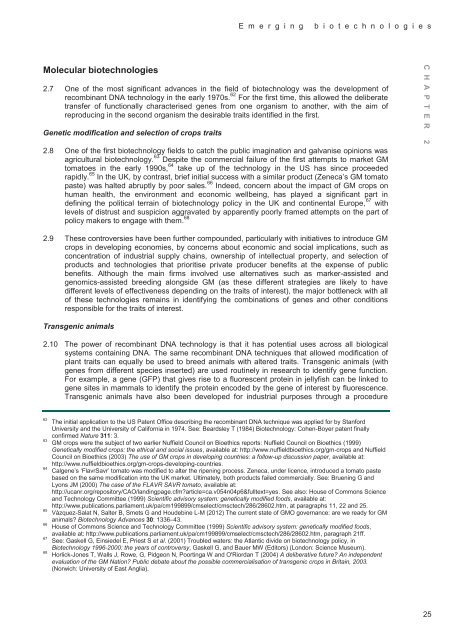Emerging biotechnologies: full report - Nuffield Council on Bioethics
Emerging biotechnologies: full report - Nuffield Council on Bioethics
Emerging biotechnologies: full report - Nuffield Council on Bioethics
You also want an ePaper? Increase the reach of your titles
YUMPU automatically turns print PDFs into web optimized ePapers that Google loves.
E m e r g i n g b i o t e c h n o l o g i e s<br />
Molecular <str<strong>on</strong>g>biotechnologies</str<strong>on</strong>g><br />
2.7 One of the most significant advances in the field of biotechnology was the development of<br />
recombinant DNA technology in the early 1970s. 62 For the first time, this allowed the deliberate<br />
transfer of functi<strong>on</strong>ally characterised genes from <strong>on</strong>e organism to another, with the aim of<br />
reproducing in the sec<strong>on</strong>d organism the desirable traits identified in the first.<br />
Genetic modificati<strong>on</strong> and selecti<strong>on</strong> of crops traits<br />
2.8 One of the first biotechnology fields to catch the public imaginati<strong>on</strong> and galvanise opini<strong>on</strong>s was<br />
agricultural biotechnology. 63 Despite the commercial failure of the first attempts to market GM<br />
tomatoes in the early 1990s, 64 take up of the technology in the US has since proceeded<br />
rapidly. 65 In the UK, by c<strong>on</strong>trast, brief initial success with a similar product (Zeneca’s GM tomato<br />
paste) was halted abruptly by poor sales. 66 Indeed, c<strong>on</strong>cern about the impact of GM crops <strong>on</strong><br />
human health, the envir<strong>on</strong>ment and ec<strong>on</strong>omic wellbeing, has played a significant part in<br />
defining the political terrain of biotechnology policy in the UK and c<strong>on</strong>tinental Europe, 67 with<br />
levels of distrust and suspici<strong>on</strong> aggravated by apparently poorly framed attempts <strong>on</strong> the part of<br />
policy makers to engage with them. 68<br />
C H A P T E R 2<br />
2.9 These c<strong>on</strong>troversies have been further compounded, particularly with initiatives to introduce GM<br />
crops in developing ec<strong>on</strong>omies, by c<strong>on</strong>cerns about ec<strong>on</strong>omic and social implicati<strong>on</strong>s, such as<br />
c<strong>on</strong>centrati<strong>on</strong> of industrial supply chains, ownership of intellectual property, and selecti<strong>on</strong> of<br />
products and technologies that prioritise private producer benefits at the expense of public<br />
benefits. Although the main firms involved use alternatives such as marker-assisted and<br />
genomics-assisted breeding al<strong>on</strong>gside GM (as these different strategies are likely to have<br />
different levels of effectiveness depending <strong>on</strong> the traits of interest), the major bottleneck with all<br />
of these technologies remains in identifying the combinati<strong>on</strong>s of genes and other c<strong>on</strong>diti<strong>on</strong>s<br />
resp<strong>on</strong>sible for the traits of interest.<br />
Transgenic animals<br />
2.10 The power of recombinant DNA technology is that it has potential uses across all biological<br />
systems c<strong>on</strong>taining DNA. The same recombinant DNA techniques that allowed modificati<strong>on</strong> of<br />
plant traits can equally be used to breed animals with altered traits. Transgenic animals (with<br />
genes from different species inserted) are used routinely in research to identify gene functi<strong>on</strong>.<br />
For example, a gene (GFP) that gives rise to a fluorescent protein in jellyfish can be linked to<br />
gene sites in mammals to identify the protein encoded by the gene of interest by fluorescence.<br />
Transgenic animals have also been developed for industrial purposes through a procedure<br />
62<br />
63<br />
64<br />
65<br />
66<br />
67<br />
68<br />
The initial applicati<strong>on</strong> to the US Patent Office describing the recombinant DNA technique was applied for by Stanford<br />
University and the University of California in 1974. See: Beardsley T (1984) Biotechnology: Cohen-Boyer patent finally<br />
c<strong>on</strong>firmed Nature 311: 3.<br />
GM crops were the subject of two earlier <str<strong>on</strong>g>Nuffield</str<strong>on</strong>g> <str<strong>on</strong>g>Council</str<strong>on</strong>g> <strong>on</strong> <strong>Bioethics</strong> <str<strong>on</strong>g>report</str<strong>on</strong>g>s: <str<strong>on</strong>g>Nuffield</str<strong>on</strong>g> <str<strong>on</strong>g>Council</str<strong>on</strong>g> <strong>on</strong> <strong>Bioethics</strong> (1999)<br />
Genetically modified crops: the ethical and social issues, available at: http://www.nuffieldbioethics.org/gm-crops and <str<strong>on</strong>g>Nuffield</str<strong>on</strong>g><br />
<str<strong>on</strong>g>Council</str<strong>on</strong>g> <strong>on</strong> <strong>Bioethics</strong> (2003) The use of GM crops in developing countries: a follow-up discussi<strong>on</strong> paper, available at:<br />
http://www.nuffieldbioethics.org/gm-crops-developing-countries.<br />
Calgene’s ‘FlavrSavr’ tomato was modified to alter the ripening process. Zeneca, under licence, introduced a tomato paste<br />
based <strong>on</strong> the same modificati<strong>on</strong> into the UK market. Ultimately, both products failed commercially. See: Bruening G and<br />
Ly<strong>on</strong>s JM (2000) The case of the FLAVR SAVR tomato, available at:<br />
http://ucanr.org/repository/CAO/landingpage.cfm?article=ca.v054n04p6&<str<strong>on</strong>g>full</str<strong>on</strong>g>text=yes. See also: House of Comm<strong>on</strong>s Science<br />
and Technology Committee (1999) Scientific advisory system: genetically modified foods, available at:<br />
http://www.publicati<strong>on</strong>s.parliament.uk/pa/cm199899/cmselect/cmsctech/286/28602.htm, at paragraphs 11, 22 and 25.<br />
Vàzquez-Salat N, Salter B, Smets G and Houdebine L-M (2012) The current state of GMO governance: are we ready for GM<br />
animals? Biotechnology Advances 30: 1336–43.<br />
House of Comm<strong>on</strong>s Science and Technology Committee (1999) Scientific advisory system: genetically modified foods,<br />
available at: http://www.publicati<strong>on</strong>s.parliament.uk/pa/cm199899/cmselect/cmsctech/286/28602.htm, paragraph 21ff.<br />
See: Gaskell G, Einsiedel E, Priest S et al. (2001) Troubled waters: the Atlantic divide <strong>on</strong> biotechnology policy, in<br />
Biotechnology 1996-2000: the years of c<strong>on</strong>troversy, Gaskell G, and Bauer MW (Editors) (L<strong>on</strong>d<strong>on</strong>: Science Museum).<br />
Horlick-J<strong>on</strong>es T, Walls J, Rowe, G, Pidge<strong>on</strong> N, Poortinga W and O'Riordan T (2004) A deliberative future? An independent<br />
evaluati<strong>on</strong> of the GM Nati<strong>on</strong>? Public debate about the possible commercialisati<strong>on</strong> of transgenic crops in Britain, 2003.<br />
(Norwich: University of East Anglia).<br />
25
















